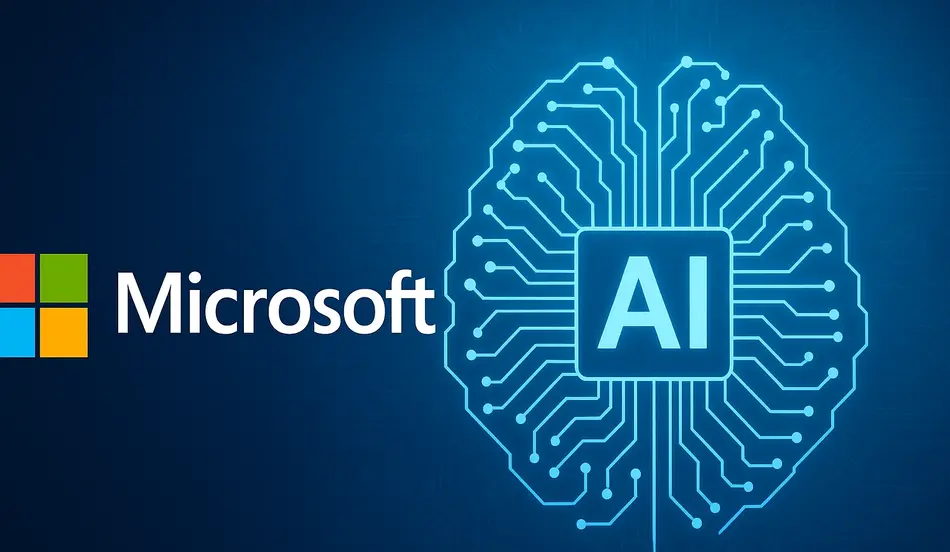Industry experts are describing Microsoft’s recent announcements of several advances in artificial intelligence as a watershed moment for the field. The company unveiled new research showing that smaller, more efficient models can outperform far larger systems, while also rolling out its first fully in-house foundation language model and a lightning-fast voice AI system.
The RStar-2 agent, a mathematics-focused model trained in a week on 64 GPUs, and two new models designed for speech and language MAI Voice 1 and MAI1 Preview are among the advancements that were unveiled this week. Together, they signal a shift in Microsoft’s approach to AI: emphasizing efficiency, adaptability, and practical deployment over sheer size.
Outperforming Giants With a Smaller Footprint
The RStar-2 agent, an experimental AI system intended to handle challenging reasoning tasks, especially in mathematics, is at the heart of Microsoft’s announcement. Unlike conventional large language models that rely on “chain-of-thought” reasoning—laying out solutions step by step—RStar-2 incorporates an interactive layer.
When solving problems, the model can write and run code, monitor its output, and make adjustments if it veers off course. Researchers compared the approach to giving the model a calculator and a notebook, rather than forcing it to rely solely on internal reasoning.
This agentic approach required solving significant infrastructure challenges. Training involved tens of thousands of concurrent tool calls, which Microsoft addressed by creating a distributed code execution system capable of handling 45,000 requests with sub-second latency. Dynamic load balancing ensured that GPUs remained fully utilized, preventing costly bottlenecks.
The training process itself was staged deliberately. In its first phase, the model focused on formatting instructions and executing code properly, with strict token limits to encourage concise reasoning. Later stages gradually introduced more complex problems and filtered out easier ones to keep the system challenged.
The results exceeded expectations. On the AIME24 benchmark, RStar-2 scored 80.6% accuracy, and 69.8% on AIME25—surpassing DeepSeek R1, a 671-billion parameter model, despite being trained on a fraction of the hardware. Moreover, the system achieved this while using fewer reasoning tokens, making it more efficient as well as more accurate.
Signs of “Reflection” in Reasoning
Researchers also observed a new phenomenon in the model’s outputs: so-called “reflection tokens.” These appeared when the system directly responded to tool feedback, such as analyzing a Python output before correcting itself. This represents a shift toward environment-driven reasoning, in contrast to traditional models that rely solely on internal logic.

Though RStar-2 was trained primarily on math, the approach demonstrated transferability, with strong performance on scientific reasoning and respectable results on alignment benchmarks. Analysts suggest the model’s adaptability could extend to fields well beyond mathematics.
MAI Voice 1: High-Speed, Natural Audio
In addition to research breakthroughs, Microsoft unveiled MAI Voice 1, a speech generation system that promises to set new industry standards for speed and quality.
The model can generate one minute of natural-sounding audio in under a second, and requires only a single GPU to run—dramatically lowering barriers for deployment in real-world applications.
Built on a transformer architecture and trained on a large multilingual dataset, MAI Voice 1 is capable of both single- and multi-speaker output across multiple languages. Microsoft has already begun integrating the model into Copilot, where it is powering some voice updates and narration features.
Its efficiency also means the technology could soon be embedded directly into consumer devices or low-latency services, offering opportunities in areas such as virtual assistants, podcasting, and interactive learning.
MAI1 Preview: Microsoft’s First In-House Foundation Model
For years, Microsoft has leaned heavily on partnerships with OpenAI and other providers for its most advanced language models. With the launch of MAI1 Preview, the company is signaling a new era of independence.
Trained on 15,000 Nvidia H100 GPUs, the model is built using a mixture-of-experts architecture and optimized for instruction following, conversational tasks, and everyday consumer use.
Rather than aiming to be the most powerful enterprise system, MAI1 Preview is tailored for practical applications—writing emails, summarizing text, answering questions, and supporting students with assignments.
The model is already available for testing on the Elmar Arena platform, where it is being benchmarked against competing models. Inside Microsoft’s own ecosystem, it is being gradually rolled out to Copilot users, beginning with text-based scenarios. The company is gathering feedback to refine the model before broader deployment.
A Shift in Strategy
Both MAI Voice 1 and MAI1 Preview were developed on Microsoft’s Next-second andture, including its custom GB200 GPU clusters. The projects brought together teams specializing in large-scale systems, speech research, and generative AI, underscoring the company’s commitment to owning more of the AI stack.
The underlying philosophy appears to be balance. Rather than chasing record-breaking model sizes, Microsoft is emphasizing efficiency, reliability, and adaptability. By demonstrating that smaller, smarter training methods can outperform brute-force approaches, the company is challenging an industry narrative that has equated scale with superiority.
Build Smarter Teams, Not Just Bigger Ones
Just as AI is shifting from scale to efficiency, your hiring strategy should focus on the right talent. Post your job on WhatJobs and connect with adaptable candidates who can drive innovation.
Post a Job Now →Industry Implications
The announcements come at a time when competition in AI development is accelerating, with Google, OpenAI, Anthropic, and a rising field of Chinese firms all vying for dominance.
For Microsoft, RStar-2’s performance is particularly significant. It suggests that the company can produce state-of-the-art reasoning capabilities without the massive infrastructure demands that often limit accessibility and deployment.
The release of MAI Voice 1 and MAI1 Preview also signals a push to deepen Microsoft’s integration of AI into its products while reducing reliance on external partners. As more AI functions are embedded directly into Windows, Office, and Copilot, Microsoft gains control not only over capabilities but also over costs and long-term strategy.
Looking Ahead
Analysts say the breakthroughs could have ripple effects across both industry and academia. Smaller research labs and startups may find inspiration in Microsoft’s demonstration that efficiency-focused approaches can level the playing field against massive models.
At the same time, the appearance of reflection tokens in RStar-2’s reasoning points to a new frontier in AI research: systems that can adapt to their environment in real time.
For consumers, the immediate impact will likely be felt in Copilot and related services, where faster, more natural voice generation and more responsive text assistance are already being rolled out.
Conclusion
Microsoft’s latest AI advances mark a decisive shift in how the company approaches artificial intelligence. By proving that efficiency and adaptability can rival—or even surpass—scale, Microsoft is challenging industry assumptions and positioning itself at the forefront of a new phase in AI development.
Whether these innovations become widely adopted remains to be seen. But with RStar-2, MAI Voice 1, and MAI1 Preview, Microsoft has shown it is no longer just riding the AI wave—it is helping to reshape its direction.
Frequently Asked Questions (FAQ)
1. What is Microsoft’s RStar-2 agent?
RStar-2 is a new AI model developed by Microsoft that specializes in complex reasoning, particularly in mathematics. Unlike typical models that rely solely on chain-of-thought reasoning, RStar-2 uses reinforcement learning to interact with external tools such as Python code execution. This makes its reasoning more reliable and adaptable.
2. How is RStar-2 different from larger AI models?
While many companies are building massive models with hundreds of billions of parameters, RStar-2 demonstrates that a smaller, more efficient model can outperform giants. It was trained in just one week on 64 GPUs, far less than what competitors typically require.
3. What is MAI Voice 1?
MAI Voice 1 is Microsoft’s new speech generation model. It can generate one minute of natural-sounding audio in under one second, and it only requires a single GPU to run. This efficiency makes it suitable for real-time applications like Copilot, virtual assistants, podcast narration, and consumer devices.
4. What is MAI1 Preview?
MAI1 Preview is Microsoft’s first fully in-house foundation language model. Trained on 15,000 Nvidia H100 GPUs, it is optimized for everyday tasks like email writing, text summarization, and Q&A. It is currently available on the Elmar Arena platform and being gradually rolled out within Microsoft Copilot.




